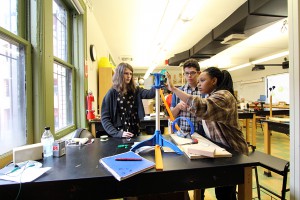Physics Leads the Way: MakerBot 3-D Printing
In the Upper School, Physics Teacher Travis Merritt has joined the 3-D printing exploration with infectious enthusiasm
Travis Merritt’s gadget-filled science lab now boasts a MakerBot 3-D printer. “It’s in an early stage. Right now it’s just one more tool available to students.” Travis teaches IB Physics to juniors and seniors and Conceptual Physics to ninth graders, and both classes work on experimental design projects. “I let students use their own ideas rather than assigning each of them a repetitive project,” he says.
One group used the MakerBot to design a working model of a wind turbine, which was tested in a simple wind tunnel they made in class. Various shapes and styles for the turbines were explored to test their efficiency. “They used the printer to learn how to iterate multiple variations of the length of an object and measure its wind resistance,” Travis explained. Another group used the printer to create a water chute, which was part of a mockup of an off-the-grid house utilizing wind, solar, and water energy.
“I’d like to see the 3-D printer used in ways that enhance the curriculum but also as an avenue for students to explore more about programming and design,” said Travis. “Having that exposure is helpful – it gives purpose to their learning.”
Indeed, some of Travis’ projects don’t fit neatly into the set curriculum, but he is known for thinking outside the box. “Rigor to me means coming up with creative solutions to problems, not going home and answering 20 physics problems every night. Yes, that’s hard but I’d rather have them apply what they know to a real problem.” One section of his classroom wall is demarcated as the Question Board. Unlock the doors of science! screams the sign atop it. All questions have a place in this class. Find a place for your keys. “The questions are keys that unlock a door,” he explained.
The board is chock full of index cards on which students have anonymously written questions they might be embarrassed to ask in class for fear of seeming unintelligent in front of their classmates. Periodically Travis will devote a few minutes of class to answering one of the questions. At other times he categorizes them and waits until they’re germane to a particular lecture. “Students are only going to invest in science if you encourage them to ask questions, to guess, to be wrong.”
In keeping with that broad philosophy, further explorations continue throughout the school. There’s no end in sight but why should there be? Travis is intense when he speaks: “Why can’t we be one of the schools that’s an early adapter? Can you imagine in the 1980’s saying to someone that computers will be in every classroom?”
Liz Harnage seconded Travis’ enthusiasm for exploration. She points out that one upper school student is already using the school’s newly purchased 3-D printing pen in her artwork. “Of utmost importance is the students designing their own work and seeing it come to fruition. This is the heart of creativity.”
NEXT: Still Your Grandparents’ Library (with an accent on high tech)

